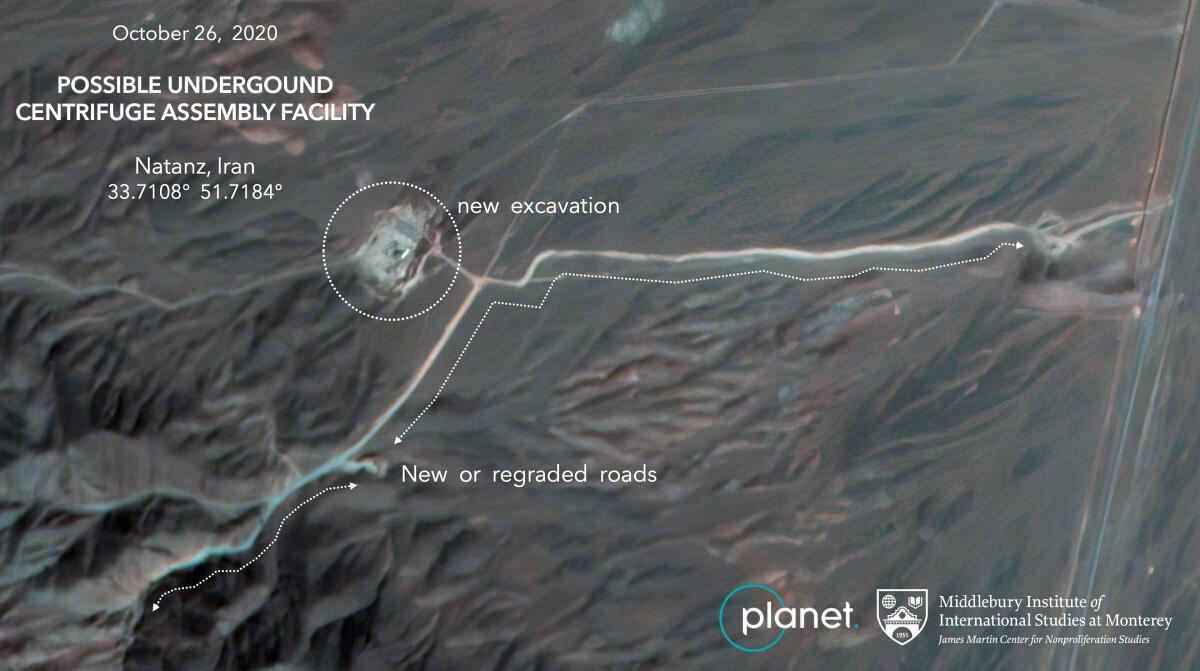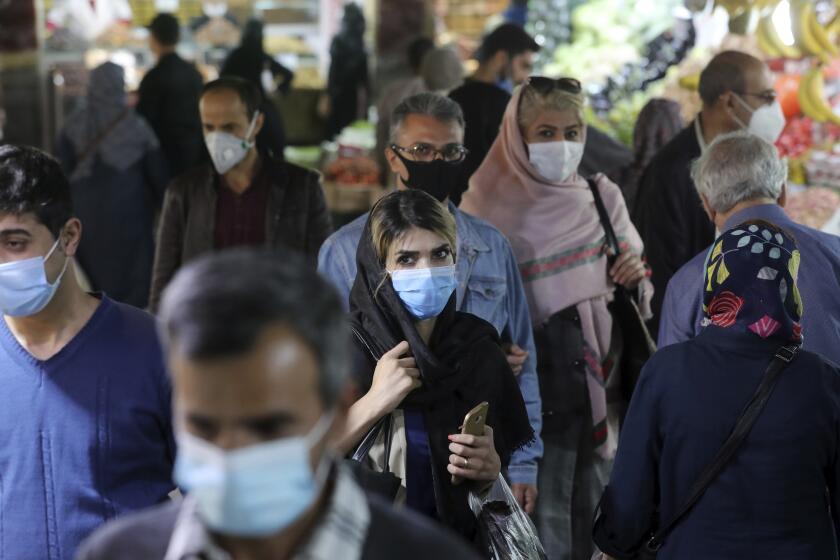Satellite photos show construction at Iranian nuclear site

- Share via
DUBAI, United Arab Emirates — Iran has begun construction at its Natanz nuclear facility, satellite images released Wednesday show, as the U.N.’s nuclear agency acknowledged that Tehran is building an underground advanced centrifuge assembly plant after its last one exploded in a reported sabotage attack over the summer.
Since August, Iran has built a new or regraded road to the south of Natanz toward what analysts believe is a former firing range for security forces at the enrichment facility, images from San Francisco-based Planet Labs show. A satellite image taken Monday shows the site cleared away with what appears to be construction equipment.
Analysts at the James Martin Center for Nonproliferation Studies at the Middlebury Institute of International Studies say they believe that the site is undergoing excavation.
“That road also goes into the mountains so it may be the fact that they’re digging some kind of structure that’s going to be out in front and that there’s going to be a tunnel in the mountains,” said Jeffrey Lewis, an expert at the institute who studies Iran’s nuclear program. “Or maybe that they’re just going to bury it there.”
The construction comes as the U.S. nears election day in a campaign between President Trump, whose maximum-pressure campaign against Iran has led Tehran to abandon all limits on its atomic program, and Joe Biden, who has expressed a willingness to return to the nuclear deal with Iran that was struck by President Obama. Heightened tensions between Iran and the U.S. nearly ignited a war at the start of the year.
Iran’s mission to the United Nations did not immediately respond to a request for comment. Ali Akbar Salehi, the head of the Atomic Energy Organization of Iran, told state television last month that the destroyed above-ground facility was being replaced with one “in the heart of the mountains around Natanz.”
Iran and Russia have obtained voter registration information and are sending disinformation to Americans ahead of election day, the leaders of U.S. intelligence agencies and the FBI warned.
Rafael Grossi, the director-general of the International Atomic Energy Agency, said Tuesday that his inspectors were aware of the construction. He said Iran had previously informed IAEA inspectors, who continue to have access to Iran’s sites despite the collapse of the nuclear deal.
“It means that they have started, but it’s not completed. It’s a long process,” Grossi said.
Iran now enriches uranium to up to 4.5% purity and, according to the last IAEA report, had a stockpile of 2.32 tons. Experts say that 1.15 tons of low-enriched uranium is usually enough material to be re-enriched up to weapons-grade levels of 90% purity for one nuclear weapon.
Iran’s so-called “breakout time” — the time needed for it to build one nuclear weapon if it chose to do so — is estimated now to have dropped from one year to as little as three months. Iran maintains that its nuclear program is for peaceful purposes, but Western countries fear Tehran could use it to pursue atomic weapons.
Iran’s health minister delivered a rare speech criticizing the government’s refusal to enforce basic health measures to slow coronavirus infections.
Natanz, built underground to harden it against airstrikes, has been at the center of those fears since its discovery in 2002. Centrifuges there still spin in vast halls under 25 feet of concrete. Air-defense positions surround the facility in Iran’s central Isfahan province.
Despite being one of the most secure sites in Iran, Natanz was targeted by the Stuxnet computer virus — believed to be the creation of the U.S. and Israel — before the nuclear deal.
In July, a fire and explosion struck its advanced centrifuge assembly facility in an incident Iran later described as sabotage. Suspicion has fallen on Israel, despite a claim of responsibility by a previously unheard-of group.
There have been tensions between the IAEA and Iran at Natanz, with Tehran accusing one inspector of testing positive for explosives last year. However, so far inspectors have been able to maintain their surveillance, which Lewis said was very important.
“As long as they declared to the IAEA in the proper time frame, there’s no prohibition on putting things underground,” he said. “For me, the real red line would be if the Iranians started to stonewall the IAEA.”
More to Read
Sign up for Essential California
The most important California stories and recommendations in your inbox every morning.
You may occasionally receive promotional content from the Los Angeles Times.















